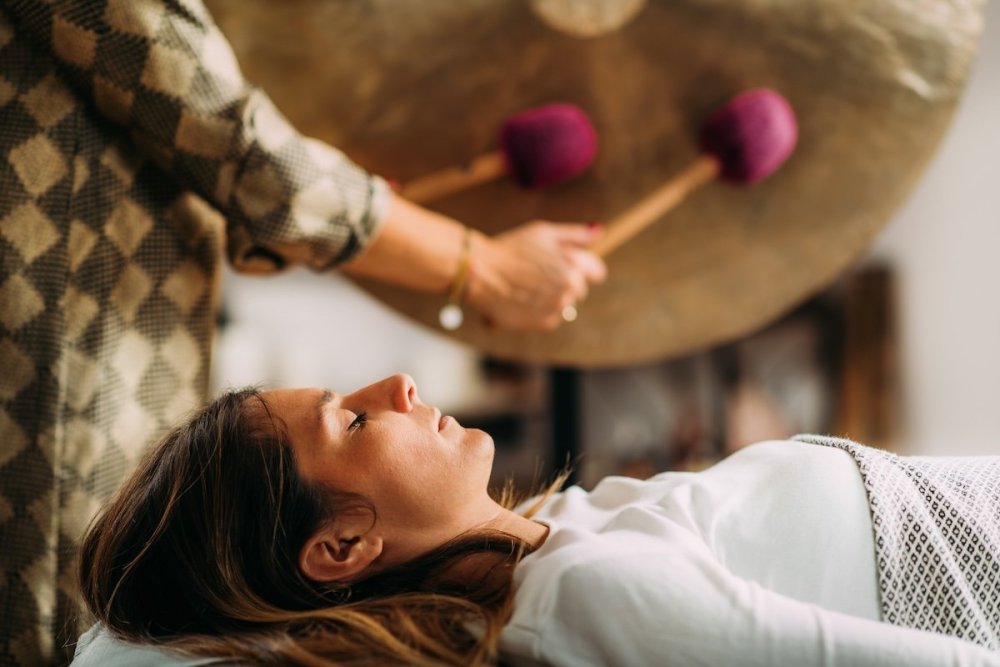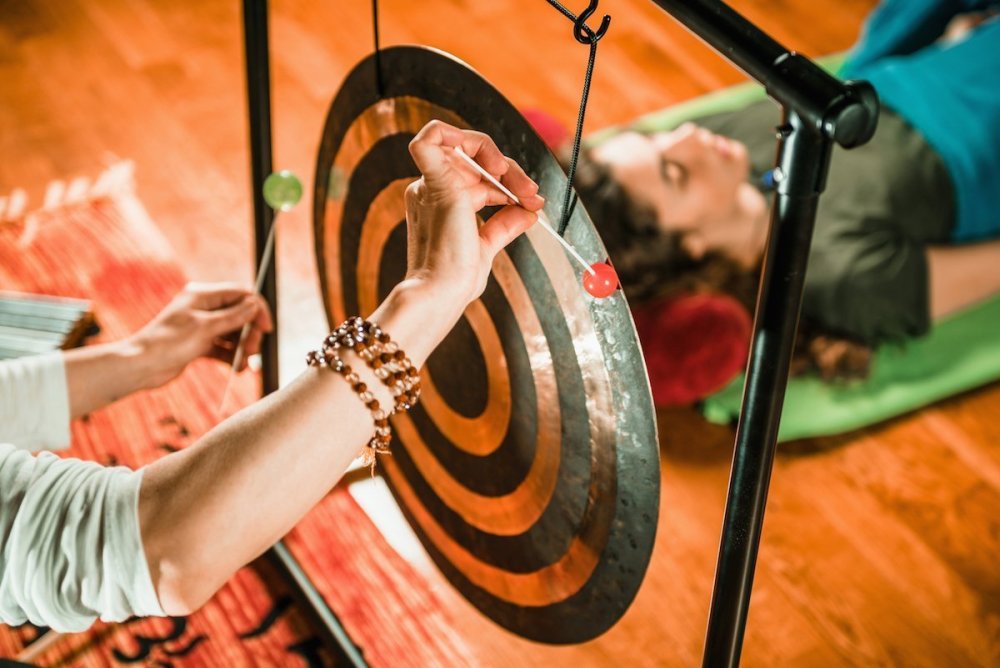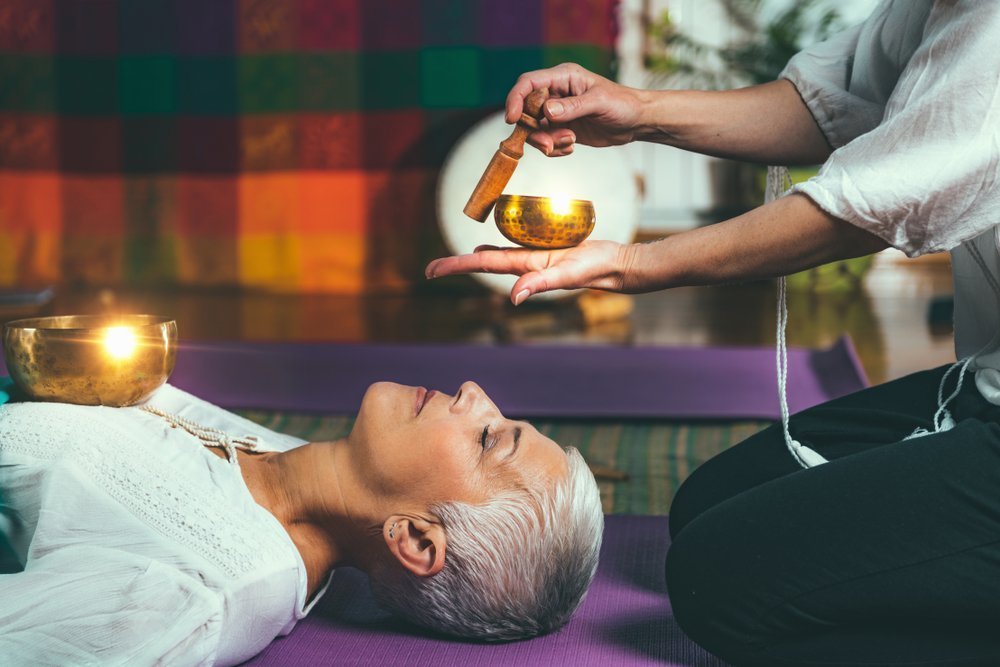The ancient art of sound bathing is growing increasingly popular. Meditation teacher Ann Vrlak explores the benefits of sound bath meditation – from reduced depression, anxiety and pain, to an enhanced sense of spirituality.
Have you heard about sound baths or sound bathing? These are actually new terms for an ancient practice.
For many hundreds of years, in various cultures, sound bathing has been part of meditation practice and healing – in some places, since the 5th century! And in Australia, aboriginal tribes have employed the didgeridoo as a sound healing instrument for over 40,000 years.
What is a sound bath?
In a traditional practice, you would be lying down in yoga corpse pose, for half an hour up to a couple of hours, as the sound bath being created around you relaxed your mind and body, and led you into a meditation.
Indeed, just as the name suggests, a sound bath fills the room with sound and envelops the listeners. In fact, it’s quite an intense experience. And, if you’re someone who finds it difficult to meditate, sound bathing may be a great way for you to settle into the practice more easily.

Sound bathing encourages a calming, meditative state
Is sound bathing like listening to music?
So, how does a sound bath differ from listening to relaxing music, for example? The difference is there in the name: it’s a sound bath, not a music bath. The sounds that are used in this kind of practice are usually singular tones produced by instruments such as crystal bowls, gongs or bells. These specialized instruments are used because the sounds they emanate invoke deep relaxation and meditative states.
Sound bathing is not about melody, but about the physical vibration of sound itself. The instruments are most often played in a way that produces deep, resonating tones that overlap each other. This creates a powerful field of vibration that is felt in body, mind and spirit – much in the same way that mantras do.
RELATED: What is Vedic Meditation? The Mantras You Need To Know
In many meditation traditions, sound is considered to be the most primordial and dynamic element in our universe. 'OM', the universal mantra, is said to be the sound of the universe itself, and its repetition will give you an increasing feeling of harmony and connection with all things that vibrate at its frequency. Whether you experience this kind of profound experience or not, the repetition of mantra, as well as sound bathing, encourages your mind to unwind by activating a deep relaxation response in your nervous system.
Sound bath benefits: the sound of the gong invokes deep relaxation
What’s a sound bath like?
I mentioned earlier that sound baths are traditionally part of a meditation practice. It is a tool to relax body and mind, so you are more receptive to a meditative state.
Today, sound bath events or sessions are used just as often solely for their relaxation benefits. Whether people come for a spiritual or relaxation experience, sound baths are extremely popular in many places.
Furthermore, sound baths are also used as therapeutic tools to heal physical and psychological illnesses. In fact, I was very lucky to experience a healing treatment myself a few years ago that involved the placement of crystal bowls on my chest that were “sung” by the therapist. At the time I thought, “This is what a cello feels like.
“Sound baths are traditionally part of a meditation practice. It is a tool to relax body and mind, so you are more receptive to a meditative state.”
The sound vibrations reverberated through my body and created a deeply meditative, thought-free and pain-free state. I’ve never heard of this kind of treatment since – though I would go again in a second if I had the chance!
For most of us, here is the kind of simple format you can expect at a sound bath event: participants lie down on their backs on a yoga mat, with blankets and pillows available. The sessions are usually conducted in a similar way to a yoga class, with several other people in the room.
The therapist then begins the sound bath. They use one or more instruments to create the series of overlapping tones, from deep low tones on a large crystal bowl, for example, to high sparkling sounds like a small chime. The sound bathing usually begins quietly with frequent silences and grows in complexity and layering. The instruments create sounds that resonate and sustain for long periods, until they disappear into silence.
RELATED:
- The Power of Silence: 10 Benefits of Cultivating Peace and Quiet
- 5 Skills You'll Learn Through Meditation
- Body Scan Meditation Script: Discover the Benefits
Sound bathing can offer some people easier access to meditation. Following the sound into silence eases your attention away from your mind, into your body and into sound – and ultimately, the silence between sounds.
If there is a guided meditation component to the session, the therapist leads you through the meditation while the sound continues. If there is no guided meditation in your session, you simply let your attention rest in the physical sensations of the sound in your body and enjoy.

Bowls are key components of sound baths
The benefits of sound baths
When you have a sound bath, you receive many of the same benefits as you'd get from a regular meditation session:
- Reduced anxiety and depression
- Activation of your body’s relaxation mechanisms
- Better focus and concentration
- Promotion of good mental health
- Enhanced self-awareness
- Better sleep
Plus, you can enjoy other benefits, like:
- The ability I touched upon earlier to move more easily into quieter, meditative states of mind
- Lowered blood pressure
- Relief of physical pain
In terms of the science behind the practice of sound bathing, research studies into its potential benefits are few and far between. However, a 2017 study from the University of California did show that Tibetan singing bowl meditation had a positive effect on participants' mood, anxiety, pain and spiritual well-being.
The study consisted of 62 participants. Compared with pre-meditation, following the sound meditation participants reported significantly reduced anger, tension, fatigue and depressive mood. Additionally, those who were previously naïve to this type of sound meditation experienced a significantly greater reduction in tension compared with participants who were experienced in this sound meditation. What's more, the feeling of spiritual well-being significantly increased across all participants.
““Sound bathing is not about melody, but about the physical vibration of sound itself. The instruments are played in a way that produces deep, resonating tones. This creates a powerful field of vibration that is felt in body, mind and spirit.”
The results of this study may point to why the practice of sound bathing has a respected place at the heart of many meditation traditions.
Want to try sound bathing?
Sound bathing is an increasingly popular practice, so hopefully you can find a practitioner near you through a simple web search. If you can't currently enjoy an in-person class, you can manage to experience a sound bath for yourself, thanks to the internet.
One group offers virtual sound baths. And you can take a three-hour (!) crystal bowl sound bath below, in high quality audio and video. I highly recommend it. You could also try creating your own sound bath at home.
Free 3-hour healing sound bath online
Shanti Bowl is one of many companies that sell Tibetan singing bowls, and they also provides instructions on how to create your own sound bath at home. If you can invest in a bowl, you’ll enjoy the added experience of making the sounds yourself and feeling the vibrations of the bell through your hands. You can listen for the tones and rhythms and silences that resonate most with you, and take you into a relaxed state.
What to wear to a sound bath meditation
If you're lucky enough to join a sound bathing meditation class, turn up in comfy, loose clothing such as jogging pants, leggings, or even PJs. Lots of people choose to wear white, as it's neutral and doesn't draw attention, but you can choose whatever colour you like.
The takeaway: sound bathing
At the very least, sound baths are one of the most unique experiences you’ll find and, at most, you may find a healing, relaxing, meditative practice that you can easily make part of your life. Especially with high quality recordings available online, sound bathing is more accessible than ever.
Having done many live sound baths myself, I heartily recommend you try one if you can. The experience of the direct sound vibrations around you are hard to describe and the benefits you feel will stay with you long after the session! •
All images: shutterstock/Microgen
happiness.com | The fine art of being: learn, practise, share
Are you a happiness.com member yet? Sign up for free now to enjoy:
■ our happiness magazine with practical life tips
■ share and support in our happiness forum
Written by Ann Vrlak
 Ann Vrlak is Founder of OneSelf Meditation and a meditation practitioner for over 25 years. She’s a Certified Meditation Teacher for adults and for children (the best job ever!). She loves to share how the perspective and practice of meditation can support people with their everyday stresses and on their journey of self-discovery.
Ann Vrlak is Founder of OneSelf Meditation and a meditation practitioner for over 25 years. She’s a Certified Meditation Teacher for adults and for children (the best job ever!). She loves to share how the perspective and practice of meditation can support people with their everyday stresses and on their journey of self-discovery.




Join the conversation
You are posting as a guest. If you have an account, sign in now to post with your account.